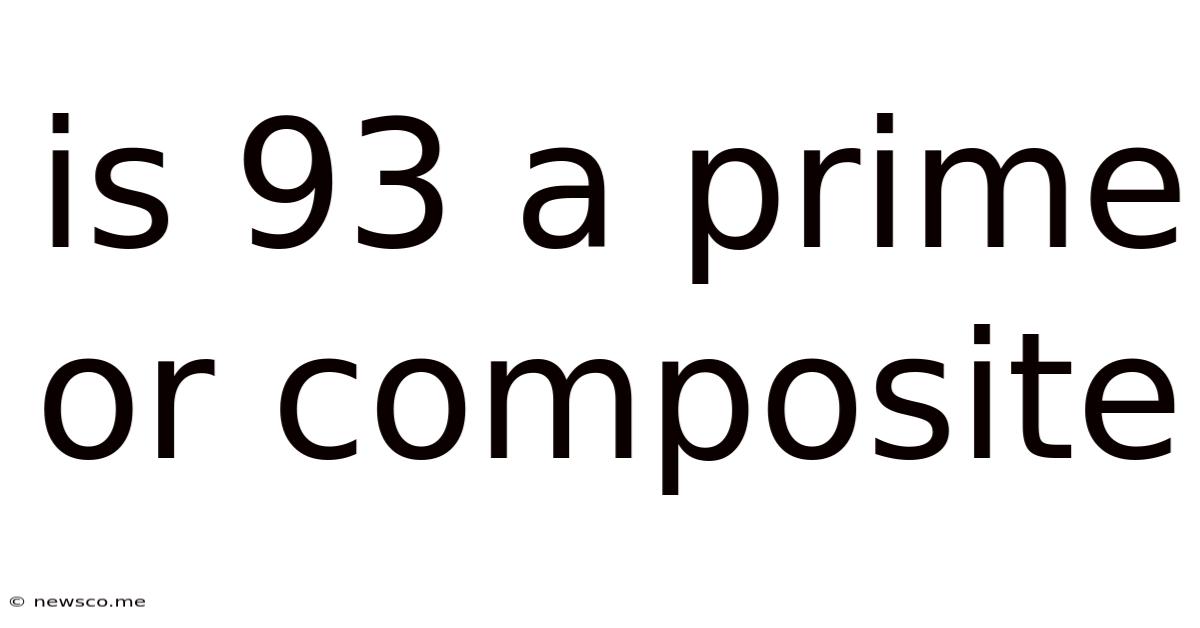Is 93 A Prime Or Composite
News Co
Apr 15, 2025 · 5 min read

Table of Contents
Is 93 a Prime or Composite Number? A Deep Dive into Number Theory
Determining whether a number is prime or composite is a fundamental concept in number theory. This seemingly simple question—is 93 prime or composite?—opens a door to exploring fascinating mathematical principles and techniques. Let's delve into this specific case and then broaden our understanding of prime and composite numbers.
Understanding Prime and Composite Numbers
Before we tackle the question directly, let's establish a clear definition of prime and composite numbers:
-
Prime Number: A prime number is a whole number greater than 1 that has only two divisors: 1 and itself. This means it's not divisible by any other whole number without leaving a remainder. Examples include 2, 3, 5, 7, 11, and so on.
-
Composite Number: A composite number is a whole number greater than 1 that has more than two divisors. In other words, it's divisible by at least one number other than 1 and itself. Examples include 4, 6, 8, 9, 10, and so on.
-
Neither Prime nor Composite: The numbers 0 and 1 are neither prime nor composite. This is a crucial distinction.
Determining if 93 is Prime or Composite
Now, let's examine the number 93. To determine if it's prime or composite, we need to check if it's divisible by any whole number other than 1 and itself. We can start by trying small prime numbers as divisors:
- Divisibility by 2: 93 is an odd number, so it's not divisible by 2.
- Divisibility by 3: The sum of the digits of 93 is 9 + 3 = 12. Since 12 is divisible by 3, 93 is also divisible by 3. Specifically, 93 ÷ 3 = 31.
Because 93 is divisible by 3 (and 31), it has more than two divisors (1, 3, 31, and 93). Therefore:
93 is a composite number.
Methods for Determining Primality
While simple division works well for smaller numbers like 93, more sophisticated methods are needed for larger numbers. Let's explore some common techniques:
1. Trial Division
This is the most straightforward method. We systematically test for divisibility by all prime numbers less than or equal to the square root of the number in question. If we find a divisor, the number is composite; otherwise, it's prime. For 93, we only needed to check divisibility by primes up to √93 ≈ 9.64. Since 3 divides 93, we concluded it's composite.
2. Sieve of Eratosthenes
This is an ancient algorithm for finding all prime numbers up to a specified integer. It works by iteratively marking as composite the multiples of each prime, starting with 2. Numbers remaining unmarked are prime. While efficient for generating a list of primes, it's not as directly applicable for testing a single number's primality.
3. Fermat's Little Theorem
This theorem provides a probabilistic test for primality. It states that if p is a prime number, then for any integer a, the number a<sup>p</sup> - a is an integer multiple of p. However, this test isn't foolproof; some composite numbers (Carmichael numbers) may pass the test.
4. Miller-Rabin Primality Test
This is a probabilistic test that's significantly more accurate than Fermat's Little Theorem. It's based on the properties of strong pseudoprimes and offers a high probability of correctly identifying primes and composites. It's widely used in cryptographic applications due to its efficiency.
5. AKS Primality Test
This is a deterministic polynomial-time algorithm that definitively determines whether a number is prime or composite. While theoretically important, it's generally less efficient than probabilistic tests for practical applications involving large numbers.
The Significance of Prime Numbers
Prime numbers are fundamental building blocks in number theory and have significant applications in various fields:
-
Cryptography: The security of many encryption methods relies on the difficulty of factoring large numbers into their prime components. RSA cryptography, for instance, is built upon this principle.
-
Hashing Algorithms: Prime numbers are often used in hashing functions to minimize collisions and ensure efficient data retrieval.
-
Coding Theory: Prime numbers play a crucial role in error-correcting codes, used in data transmission and storage to detect and correct errors.
-
Random Number Generation: Prime numbers are essential in generating sequences of pseudo-random numbers, crucial in simulations and statistical modeling.
Beyond 93: Exploring Other Numbers
Let's briefly analyze the primality of a few other numbers to further solidify our understanding:
- 101: This number is only divisible by 1 and itself, so it's prime.
- 143: 143 = 11 × 13, making it composite.
- 257: This is a prime number. You would need to test for divisibility by primes up to √257 ≈ 16.
- 511: 511 = 7 × 73, making it composite.
Conclusion: The Importance of Understanding Prime and Composite Numbers
Determining whether a number like 93 is prime or composite is more than just a mathematical exercise. It underscores the importance of understanding fundamental number theory concepts. The methods we've discussed – from simple trial division to sophisticated probabilistic and deterministic tests – highlight the ongoing evolution of mathematical tools for tackling such problems. This knowledge finds practical applications in diverse fields, particularly in the realms of cryptography and computer science, demonstrating the far-reaching impact of seemingly simple concepts like primality. The seemingly simple question of "Is 93 prime or composite?" serves as a gateway to a much larger and fascinating world of mathematical exploration. Continuing to explore these topics deepens one's understanding of the foundational building blocks of mathematics and their profound impact on modern technology.
Latest Posts
Related Post
Thank you for visiting our website which covers about Is 93 A Prime Or Composite . We hope the information provided has been useful to you. Feel free to contact us if you have any questions or need further assistance. See you next time and don't miss to bookmark.